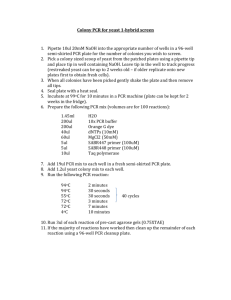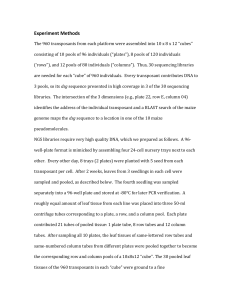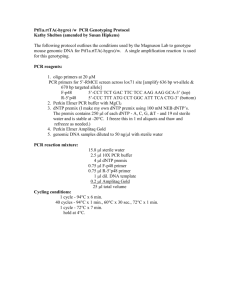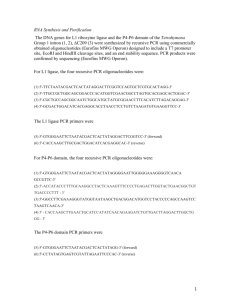Protocol: rDNA Cloning, Transformation, and Colony Screening
advertisement
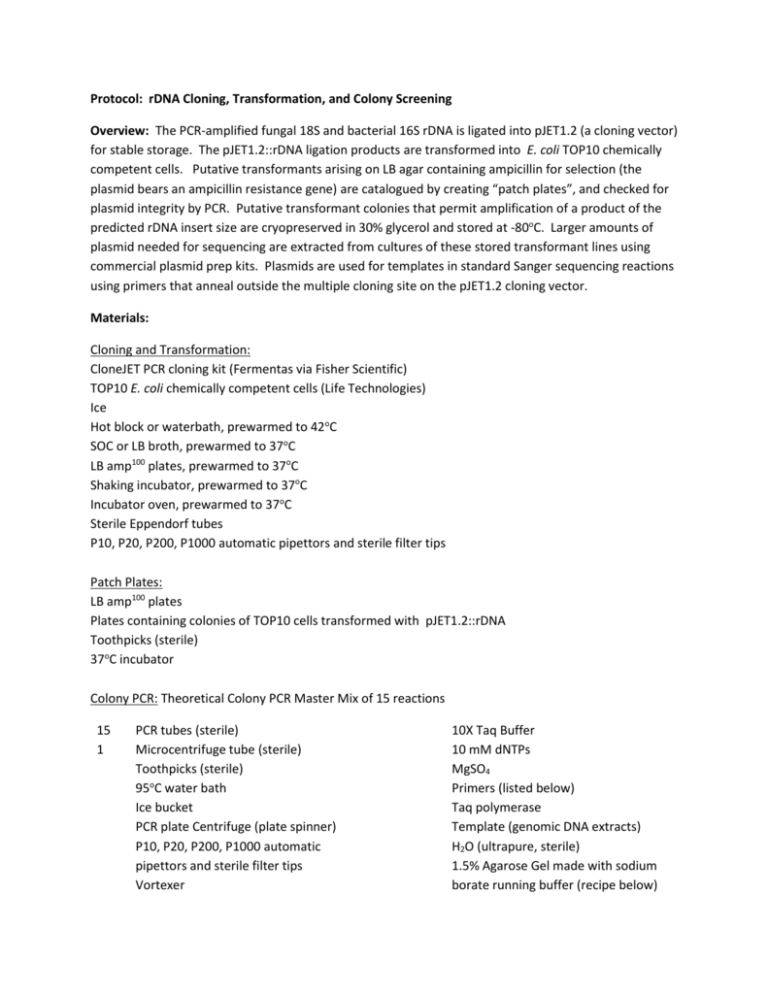
Protocol: rDNA Cloning, Transformation, and Colony Screening Overview: The PCR-amplified fungal 18S and bacterial 16S rDNA is ligated into pJET1.2 (a cloning vector) for stable storage. The pJET1.2::rDNA ligation products are transformed into E. coli TOP10 chemically competent cells. Putative transformants arising on LB agar containing ampicillin for selection (the plasmid bears an ampicillin resistance gene) are catalogued by creating “patch plates”, and checked for plasmid integrity by PCR. Putative transformant colonies that permit amplification of a product of the predicted rDNA insert size are cryopreserved in 30% glycerol and stored at -80oC. Larger amounts of plasmid needed for sequencing are extracted from cultures of these stored transformant lines using commercial plasmid prep kits. Plasmids are used for templates in standard Sanger sequencing reactions using primers that anneal outside the multiple cloning site on the pJET1.2 cloning vector. Materials: Cloning and Transformation: CloneJET PCR cloning kit (Fermentas via Fisher Scientific) TOP10 E. coli chemically competent cells (Life Technologies) Ice Hot block or waterbath, prewarmed to 42oC SOC or LB broth, prewarmed to 37oC LB amp100 plates, prewarmed to 37oC Shaking incubator, prewarmed to 37oC Incubator oven, prewarmed to 37oC Sterile Eppendorf tubes P10, P20, P200, P1000 automatic pipettors and sterile filter tips Patch Plates: LB amp100 plates Plates containing colonies of TOP10 cells transformed with pJET1.2::rDNA Toothpicks (sterile) 37oC incubator Colony PCR: Theoretical Colony PCR Master Mix of 15 reactions 15 1 PCR tubes (sterile) Microcentrifuge tube (sterile) Toothpicks (sterile) 95oC water bath Ice bucket PCR plate Centrifuge (plate spinner) P10, P20, P200, P1000 automatic pipettors and sterile filter tips Vortexer 10X Taq Buffer 10 mM dNTPs MgSO4 Primers (listed below) Taq polymerase Template (genomic DNA extracts) H2O (ultrapure, sterile) 1.5% Agarose Gel made with sodium borate running buffer (recipe below) Primers for colony PCR and for subsequent sequencing: pJET2.1 forward sequencing primer (CGACTCACTATAGGGAGAGCG) pJET2.1 reverse sequencing primer (AAGAACATCGATTTTCCATGG) Protocol: Cloning and Transformation 1. 2. 3. 4. Perform pJet1.2 cloning according to manufacturer’s directions Perform TOP10 chemically competent cell transformation according to manufacturer’s directions Plate 25 uL of transformation mixture onto one LBamp100 plate* and the remainder onto another. Incubate at 37oC for no longer than 20h. Satellite colonies** are likely to form at this point. *Make sure your ampicillin was added to warm, not hot agar (heat inactivates ampicillin) and that plates were stored in the dark at 4oC after pouring (light also inactivates ampicillin). Plates should be no more than two weeks old, or the ampicillin will age and degrade. **Satellite colonies are plasmid-less offspring of the parent colony, or contaminants are permitted to survive upon the eventual breakdown of ampicillin by secreted beta-lactamase enzymes from the transformants. Patch plate layout: 5. To make patch plates, use a sterile toothpick to lightly touch a colony on a plate of transformants. Avoid satellite colonies and colonies near the edge of the plate where contaminants might have gotten in. 6. Swipe toothpick on the area on a marked plate (see example of a mapped plate to the left) designated for that particular clone. A 1-cm swipe is plenty. Pick between 4-8 transformants of each cloning reaction, depending on your success rate. Because our ordering system gives each isolate a letter designation, please use numbers to designate which transformant you plate – e.g. A-1, A-2, A-3, and so on. 7. Place patch plates in 37oC incubator for 16-20 hours. 8. Store plates at 4oC. Colony PCR Master Mix (for a PCR with 13 reactions; make a master mix for 15 reactions) Initial Concentrations 10x Buffer 10mM dNTPs 50mM MgSO4 Primer Forward 10uM Reverse 10uM Taq 5U/uL Template DNA H20 Final concentrations 1x 0.2mM 1.5mM Final vol/10uL Rxn 1uL 0.2 uL 0.3 uL MM vol for 15 Rxn 15 uL 3 uL 4.5 uL 0.5uM 0.5uM 0.25U N/A N/A 0.5 uL 0.5 uL 0.05 uL 1 uL 6.45uL 7.5 uL 7.5 uL 0.75 uL N/A 96.75uL Thermal Cycler Conditions: Initial denaturation: 94oC for 3 min Denaturation: 94oC for 30 sec Annealing: 60oC for 30 sec Extension: 72oC for 1 min Final extension: 72oC for 5 min Hold: 4oC forever X 35 cycles (Follow general precautions outlined in “PCR and Gel Extraction of rDNA” protocol.) 1. Program thermal cycler to heat to 95oC for 10 minutes. 2. Fill 13 PCR tubes with 10uL sterile ultrapure water 3. Inoculate PCR tubes with a tiny amount of TOP10 transformant cells by touching toothpick to patch on patch plate, and then swirling in PCR tube filled with 10uL water. Inoculate only 12 tubes; the 13th is the negative control. 4. Place inoculated PCR tubes into 95oC thermocycler for 10 min. This will lyse the cells. 5. Pellet cells by centrifuging for 10min at 1400 rpm. If using plate spinner, for greatest separation, place tubes in outmost part of rack. The supernatant contains plasmid DNA which you’ll use as your PCR template 6. Label microcentrifuge tube for master mix (MM) and label 13 unused PCR tubes. Place on ice. 7. Add sterile water to MM tube. 8. Vortex and add proper amounts of buffer, dNTPs and MgSO4 to MM tube 9. Add Taq to MM. 10. Aliquot 9uL of MM into each of the 13 labeled PCR tubes. 11. Add proper template DNA to each PCR tube. Replace template DNA with water for negative control. 12. Ensure PCR tubes are securely shut and place into thermal cycler. 13. Run thermal cycler program. 14. Store purified PCR product in -20oC. 15. Separate PCR products on a 2% agarose gel, using sodium borate (SB) buffer as the running buffer. Image, and analyze whether the amplification product represents an insert of the expected size. 16. Colonies yielding the expected PCR product are stored in 30% glycerol at -80oC. 17. Plasmid is extracted from “positive” colonies and sequenced with the appropriate sequencing primers (listed above). 18. Sequence of inserts is edited, trimmed, and aligned using standard bioinformatics techniques, and compared with extant databases for species identification. 20X sodium borate buffer stock solution, pH ~8.2 Ingredient Amount Molarity in 1X solution NaOH 8g (MW = 40) 10 mM Boric acid 47 g (MW = 61.83) 38 mM Total volume 1000 mL ----Add 8g NaOH and 47g boric acid to 900ml distilled water, and stir to dissolve completely. Bring final volume to 1L. Use 0.2 micron filter membrane to filter. pH should be around 8.2. This protocol makes a 20X stock solution, i.e. dilute 50 mL in 1L distilled water for a 1X solution.
